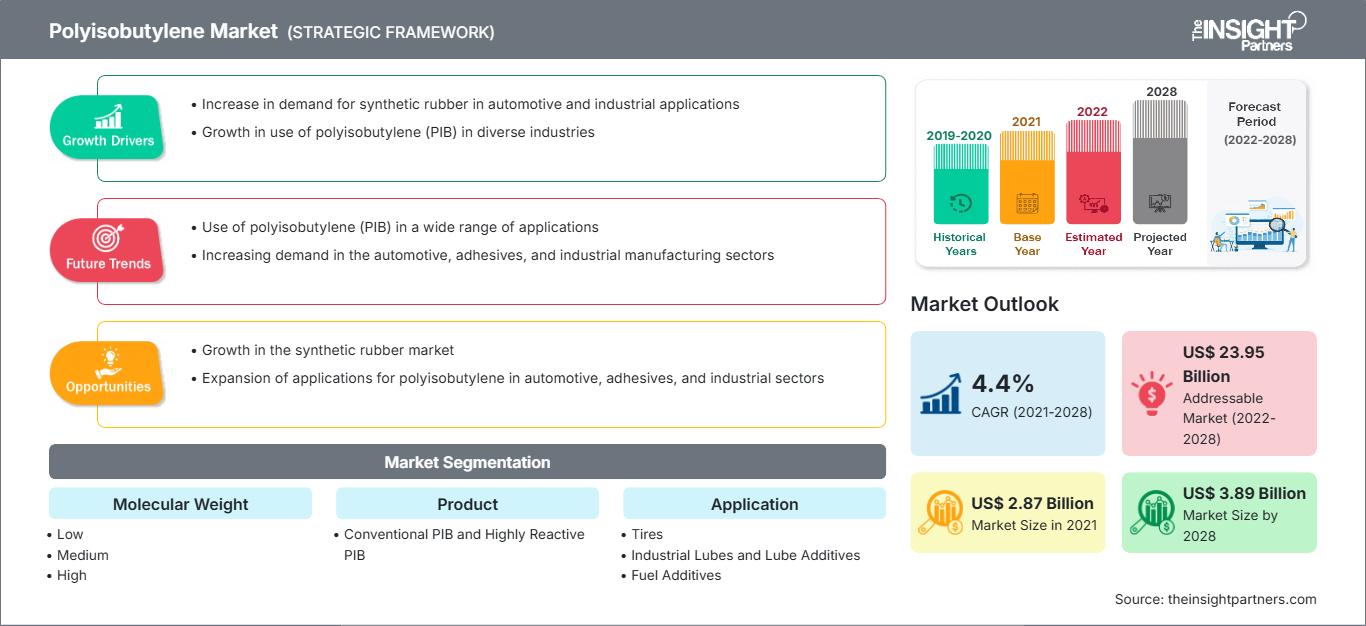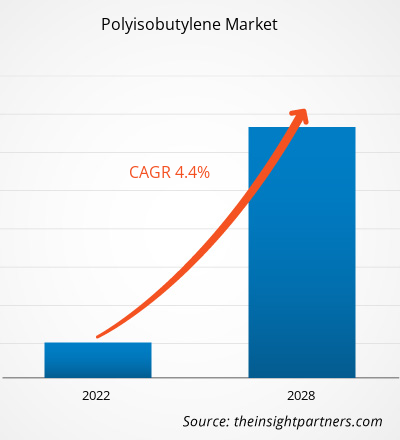[Forschungsbericht]Der Polyisobutylenmarkt wurde im Jahr 2021 auf 2.871,14 Millionen US-Dollar geschätzt und soll bis 2028 3.891,16 Millionen US-Dollar erreichen; von 2021 bis 2028 wird ein CAGR-Wachstum von 4,4 % erwartet.
Polyisobutylen (PIB) ist ein Elastomer bzw. synthetischer Kautschuk. Der Markt ist nach Molekulargewicht in niedrig, mittel und hoch segmentiert. Es ist eine vielseitige, ungiftige und wasserhelle viskose Flüssigkeit. Polyisobutylen kann die Klebrigkeit erhöhen, wasserabweisend machen, den Viskositätsindex verbessern und eine hervorragende elektrische Isolierung bieten. Im Jahr 2020 hatte Nordamerika den größten Umsatzanteil am globalen Polyisobutylenmarkt. Steigende Nachfrage aus verschiedenen Anwendungen, wie z. B. Transport, Agrochemie, Elektrik und Klebstoffe, treibt das Wachstum des nordamerikanischen Marktes voran. Polyisobutylen wird zunehmend in der Transport-, Lebensmittel- und Bauindustrie eingesetzt, da es eine geringe Gasdurchlässigkeit, ausgezeichnete Zugfestigkeit, hohe chemische Beständigkeit und erhöhte Steifigkeit bietet.
Passen Sie diesen Bericht Ihren Anforderungen an
Sie erhalten kostenlos Anpassungen an jedem Bericht, einschließlich Teilen dieses Berichts oder einer Analyse auf Länderebene, eines Excel-Datenpakets sowie tolle Angebote und Rabatte für Start-ups und Universitäten.
Polyisobutylen-Markt: Strategische Einblicke

-
Holen Sie sich die wichtigsten Markttrends aus diesem Bericht.Dieses KOSTENLOSE Beispiel umfasst Datenanalysen, die von Markttrends bis hin zu Schätzungen und Prognosen reichen.
Auswirkungen der COVID-19-Pandemie auf den Polyisobutylen-Markt
Die COVID-19-Pandemie hat den Status des Chemie- und Werkstoffsektors drastisch verändert und das Wachstum des Polyisobutylen-Marktes negativ beeinflusst.
Die globale Chemie- und Werkstoffindustrie ist eine der Hauptbranchen, die unter schweren Störungen durch die Pandemie leidet, wie z. B. Unterbrechungen der Lieferkette, Absagen von Technologieveranstaltungen und Büroschließungen. Die von Ländern in Europa, Asien und Nordamerika verhängten weltweiten Reiseverbote beeinträchtigen die Möglichkeiten für geschäftliche Zusammenarbeit und Partnerschaften. All diese Faktoren werden voraussichtlich die Elektronik- und Chemie- und Werkstoffindustrie negativ beeinflussen, was das Wachstum verschiedener mit diesen Branchen verbundener Märkte behindert. Da die Volkswirtschaften jedoch planen, ihre Aktivitäten wieder anzukurbeln, wird erwartet, dass die Nachfrage nach Polyisobutylen weltweit steigen wird. Die Nachfrage nach Polyisobutylen aus den nachgelagerten Sektoren industrieller Schmierstoffe und Schmierstoffadditive hat mit der Wiederaufnahme der Geschäftstätigkeit und der Aufhebung der Lockdown-Maßnahmen weltweit zu steigen begonnen. Markteinblicke: Automobilindustrie treibt Marktwachstum im Prognosezeitraum anFür die Automobilindustrie ist die Leistung der Motoren zur Erfüllung ihrer täglichen Funktionen wichtig. Die Automobilindustrie ist seit vielen Jahren der wichtigste Markt für verschiedene Arten von Kraftstoffadditiven. Der Anteil der Autos war aufgrund des Mangels an effizienten Alternativen zu fossilen Brennstoffen und einer wachsenden Mittelschichtwirtschaft kontinuierlich höher als der des anderen Marktsegments für Kraftstoffadditive. Die relative Bedeutung der Luftfahrt für Kraftstoffadditive hat in den letzten Jahren zugenommen, was letztendlich die Nachfrage nach Polyisobutylen erhöht hat.
Anwendungseinblicke
Basierend auf der Anwendung ist der globale Polyisobutylenmarkt in Reifen, industrielle Schmierstoffe und Schmierstoffadditive, Kraftstoffadditive, Klebstoffe und Dichtstoffe und Sonstiges unterteilt. Das Segment Industrieschmierstoffe und Schmierstoffadditive hatte 2020 den größten Marktanteil. Polyisobutylen (PIB) reagiert mit Maleinsäureanhydrid zu Polyisobutenylbernsteinsäureanhydrid (PIBSA), einem Grundbaustein für Dispergiermittel in Schmierölen und Detergenzien in Kraftstoffen. Die andere Variante, Polyisobutylensuccinimid (PIBSI), das aus Polyisobutylen (PIB) gewonnen wird, wirkt als antioxidativer Emulgator in löslichen Metallbearbeitungsflüssigkeiten und als Baustein für Schmierstoffadditive. PIB verbrennen außerdem sauberer und eignen sich daher ideal für den Einsatz in Zweitaktmotorenölen und Schiffsanwendungen, bei denen Schmierstoffe den starken Blow-by-Gasen großer Dieselmotoren ausgesetzt sind.
BASF SE, Braskem SA, Daelim Industrial Petrochemical Division, Ineos AG, Infineum International Limited., Kothari Petrochemicals., Sibur Holding PJSC, Kemat Polybutenes, The Lubrizol Corporation und TPC Group gehören zu den wichtigsten Akteuren auf dem globalen Polyisobutylenmarkt. Die Akteure auf dem Markt konzentrieren sich stark auf die Entwicklung hochwertiger und innovativer Produktangebote, um die Anforderungen der Kunden zu erfüllen.
Polyisobutylen
Regionale Einblicke in den Polyisobutylen-Markt
Die Analysten von The Insight Partners haben die regionalen Trends und Faktoren, die den Polyisobutylenmarkt im Prognosezeitraum beeinflussen, ausführlich erläutert. In diesem Abschnitt werden auch die Marktsegmente und die geografische Lage von Polyisobutylen in Nordamerika, Europa, Asien-Pazifik, dem Nahen Osten und Afrika sowie Süd- und Mittelamerika erläutert.
Umfang des Polyisobutylen-Marktberichts
| Berichtsattribut | Einzelheiten |
|---|---|
| Marktgröße in 2021 | US$ 2.87 Billion |
| Marktgröße nach 2028 | US$ 3.89 Billion |
| Globale CAGR (2021 - 2028) | 4.4% |
| Historische Daten | 2019-2020 |
| Prognosezeitraum | 2022-2028 |
| Abgedeckte Segmente |
By Molekulargewicht
|
| Abgedeckte Regionen und Länder |
Nordamerika
|
| Marktführer und wichtige Unternehmensprofile |
|
Dichte der Marktteilnehmer für Polyisobutylen: Verständnis ihrer Auswirkungen auf die Geschäftsdynamik
Der Polyisobutylen-Markt wächst rasant, angetrieben durch die steigende Endverbrauchernachfrage aufgrund von Faktoren wie sich entwickelnden Verbraucherpräferenzen, technologischem Fortschritt und einem stärkeren Bewusstsein für die Produktvorteile. Mit steigender Nachfrage erweitern Unternehmen ihr Angebot, entwickeln Innovationen, um den Verbraucherbedürfnissen gerecht zu werden, und nutzen neue Trends, was das Marktwachstum weiter ankurbelt.

- Holen Sie sich die Polyisobutylen-Markt Übersicht der wichtigsten Akteure
Berichts-Spotlights
- Fortschreitende Branchentrends im Polyisobutylen-Markt helfen den Akteuren bei der Entwicklung effektiver langfristiger Strategien
- Geschäftswachstumsstrategien in entwickelten und sich entwickelnden Märkten
- Quantitative Analyse des Polyisobutylen-Marktes von 2019 bis 2028
- Schätzung der weltweiten Nachfrage nach Polyisobutylen
- Porters Fünf-Kräfte-Analyse zur Veranschaulichung der Wirksamkeit von Käufern und Lieferanten in der Branche
- Jüngste Entwicklungen zum Verständnis des wettbewerbsorientierten Marktszenarios
- Markttrends und -aussichten sowie Faktoren, die das Wachstum des Polyisobutylen-Marktes vorantreiben und hemmen
- Unterstützung im Entscheidungsprozess durch Hervorhebung von Marktstrategien, die das kommerzielle Interesse untermauern und zum Marktwachstum führen
- Die Größe des Polyisobutylen-Marktes an verschiedenen Knotenpunkten
- Detaillierte Übersicht und Segmentierung des Marktes sowie der Polyisobutylen-Branche Dynamik
- Größe des Polyisobutylen-Marktes in verschiedenen Regionen mit vielversprechenden Wachstumschancen
Polyisobutylen-Markt
Nach Molekulargewicht
- Niedrig
- Mittel
- Hoch
- Produkt
- Konventionelles PIB
- Hochreaktives PIB
Anwendung
- Reifen
- Industrieschmierstoffe und Schmierstoffadditive
- Kraftstoffadditive
- Kleb- und Dichtstoffe
- Sonstige
Endverbraucherindustrie
- Industrie
- Lebensmittel
- Sonstige
Unternehmensprofile
- BASF SE
- Braskem SA
- Daelim Industrial Petrochemical Division
- Ineos AG
- Infineum International Limited.
- Kemat Polybutenes
- Kothari Petrochemicals
- Sibur Holding PJSC
- The Lubrizol Corporation
- TPC Group
- Historische Analyse (2 Jahre), Basisjahr, Prognose (7 Jahre) mit CAGR
- PEST- und SWOT-Analyse
- Marktgröße Wert/Volumen – Global, Regional, Land
- Branchen- und Wettbewerbslandschaft
- Excel-Datensatz
Aktuelle Berichte
Erfahrungsberichte
Grund zum Kauf
- Fundierte Entscheidungsfindung
- Marktdynamik verstehen
- Wettbewerbsanalyse
- Kundeneinblicke
- Marktprognosen
- Risikominimierung
- Strategische Planung
- Investitionsbegründung
- Identifizierung neuer Märkte
- Verbesserung von Marketingstrategien
- Steigerung der Betriebseffizienz
- Anpassung an regulatorische Trends






















 Kostenlose Probe anfordern für - Polyisobutylen-Markt
Kostenlose Probe anfordern für - Polyisobutylen-Markt